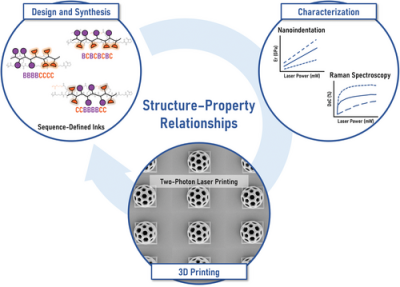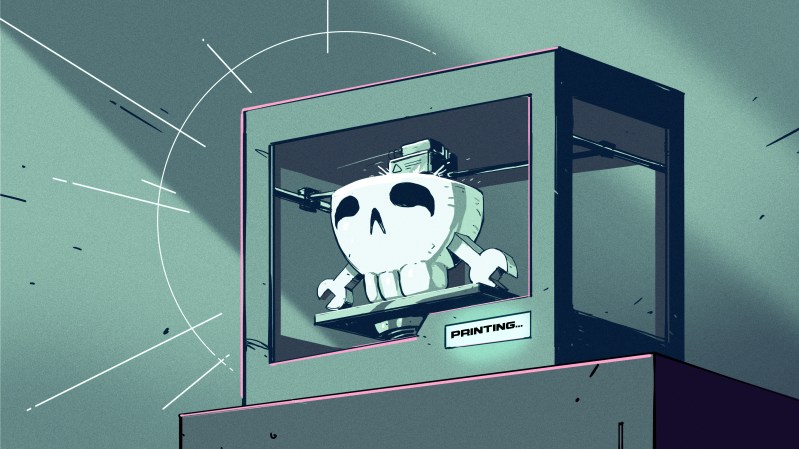When we think about 3D printing, our mind often jumps to hot nozzles squirting out molten plastic. Other popular techniques include flashing bright light into resin, or using lasers to fuse together metal powders. All these techniques are great at producing parts with complicated geometries at desktop scales.
However, it’s also possible to 3D print at altogether microscopic scales. Researchers in Germany have now developed advanced macromolecular “inks” that can be used to create microscopic 3D sculptures with finer control than ever before.
Exacting Requirements

At the cutting edge of 3D printing, Eva Blasco’s team at the University of Heidelberg has successfully created 3D printed structures with meticulously designed molecular sequences. This technique echoes the precision found in polymers in the natural world – akin to the way DNA can code for precisely specific amino acids of exacting composition.
Researchers first meticulously engineered the molecular sequence of their inks, with an eye to gaining unprecedented control of the printed product’s fundamental properties. In simpler terms, Blasco and her team worked to arrange molecules in a custom sequence to create unique structures with exacting properties.
Blasco’s team created a series of inks, each with unique permutations of eight molecular units, to observe how changing the sequence impacts the properties of the printed structures. These are referred to as sequence-defined or macromolecularly-defined polymers in the scientific literature. They often require complex chemical synthesis in order to produce molecules with the precise desired structure. These precision-built molecules could have wider applications in realms like data storage, cryptography, or pharmaceutical applications, assuming researchers can master their manipulation at the molecular level.
In the case of Blasco’s research, the aim was to determine whether different sequence-defined macromolecules could create materials with varying properties. The goal was to precisely engineer the molecules to be suited for a 3D printing like process called two-photon laser printing, or 2PLP. Currently popular as a tool for working with microfluidics and micro-optics, it can be used to create tiny structures at the microscopic level. Focused laser light is used to polymerize a material at a precise spot, over and over again, to build up 3D structures. As it stands, currently available commercial materials for this use are considered imprecise in composition. Thus, the goal was to create molecularly-exact inks for this polymerization process.
The research team created three different sequences of macromolecule using (B) non-functional and photocrosslinkable (C) units. The sequences used were alternating (BCBCBCBC), triblock (CCBBBBCC) and block (BBBBCCCC). The changes in sequence had direct effects on the printability of the inks, due to the distinct structures at the molecular level.

The inks were used to print a variety of microstructures which were then assessed for their mechanical and chemical properties. This was achieved with nanoindentation testing and Raman spectroscopy, respectively. It took some finesse, both in synthesis and control of the laser printing process, but the team was able to produce a variety of structures using the new inks.
Notably, the results showed that the alternating structure had the best printability of the three tested. The block structure had the lowest Young’s Modulus, outperformed by triblock, with the alternating sequence posting the highest result, and thus exhibiting the greatest stiffness. Meanwhile, chemical analysis showed that the block structure required the highest laser power to produce stable structures, while the alternating version produced stable prints with lower laser powers and a lower degree of cross-linking.
The above initial tests were performed on simple buckyball structures printed with the 2PLP method. However, to better showcase the performance of the inks, the research team also 3D printed some more complex structures, akin to the way that the Benchy benchmark model is used to get a holistic view of a regular 3D printer’s performance. The researchers printed a toucan model using the alternating structure ink, showing off a large 10 um overhang on the bird’s beak. The triblock ink was used to print a koala, showing off finely detailed fur, while a kangaroo model printed with the block ink again demonstrating successful overhangs and fine details.
The value of this research is that it shows that viable sequence-defined inks can be produced for the 2PLP microprinting process. After all, it only makes sense that you’d want to control your inks on as fine a level as possible when producing features at micrometer scales. While the technology was demonstrated with the production of simple microsculptures, these techniques could prove vital to a variety of tiny fabrication tasks. Whether you’re looking at the production of tiny optical components, microfluidic tooling, or microrobotics, having the ultimate control over material properties at the molecular level is key.

















So the world smallest violin can now be made even smaller?
and you thought removing support on a regular print was a pain.
they should print a benchy